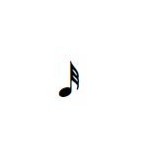Too Quaver
What do you see?
In one of my fateful lets sit down with a coffee episodes, I seriously began to wonder about how we teach duration. This little picture is for me a division of sound that has a multitude of lengths depending upon the context it is placed.
 For Me that first little picture is exactly half the duration of the next little picture if they are placed within the same metronomic context. If the pulse stays steady, if the piece started at 98 beats per minute, and stays at 98 beats per minute throughout reading both these little pictures, then I know that the qrotchet (the second little picture) can happen 98 times a minute, and the quaver (the first little picture) can happen twice as many times in that minute. I think thats 196 beats per minute. And that for me is all these little pictures are.
For Me that first little picture is exactly half the duration of the next little picture if they are placed within the same metronomic context. If the pulse stays steady, if the piece started at 98 beats per minute, and stays at 98 beats per minute throughout reading both these little pictures, then I know that the qrotchet (the second little picture) can happen 98 times a minute, and the quaver (the first little picture) can happen twice as many times in that minute. I think thats 196 beats per minute. And that for me is all these little pictures are.
Although you change whether they sound high or low by moving them up and down on the lines you normally find them on.
The reason for the initial question is that I’ve read them for so long that I forgot they had a meaning by themselves, and although they tend to be taught initially by statements like
slow and quick (opposites, not a movement direction! :-)) or long and short (durations, not all encompassing! :-)). These meanings even when I was learning them seemed a little too abstract, and not precise at the same time (you can, I hope, understand that as a passionate mathematician my command of the english language had just been completely shattered).
I think I would have understood if it was taught like… Dude what’s taking so long….. (This is a semibreve, and in context only 24 of these per minute.)
Dude what’s taking so long….. (This is a semibreve, and in context only 24 of these per minute.)
and….
 Nope, didn’t quite get that one…. (This is a demi-semi-quaver, in context there are 768 of these per minute)
Nope, didn’t quite get that one…. (This is a demi-semi-quaver, in context there are 768 of these per minute)
I would have completely understood straight off the bat. It would have also explained duration to me in a way that fit into my world, AND (this is the crucial bit) my english descriptors for mathematics would still be intact today.
You see, if you actually count the pulse to determine the length of a semi-breve then you have ruined the musical feeling of it being a single note, and if you try and mathematically work out something like a demi-semi-quaver and then play it, it’s ‘game over’ already.


The beauty of teaching little ones is that ‘ignorance is bliss’ and we can feed them so much information unawares in this paradigm 🙂 If one were to ask the question – what came first, the picture or the sound? -Is it not true that these pictures are actually the adjectives in themselves – little pictures describing sounds?
Understanding the mathematics is essential to the mature musician – but like a class of six year olds saying their two times tables by rote – the understanding of the concept comes much later.
Such it is with the complexities of rhythm 🙂
Further to – as to your question regarding how to teach duration may I quote from one of your earlier posts:
“If I then take a look at the way all cultures that I have been exposed to have developed, they also follow this recipe.
Someone did a little bit of something, made a noise perhaps. This action changed how they were perceiving life, for If no sound existed that they liked, they could make one! They could now interact with the world they knew differently.
Someone else heard this, copied it and added a few more sounds.
This process continued until pretty soon a song was being sung…”
I’m not sure if we could ever fully understand these pictures without hearing first…?